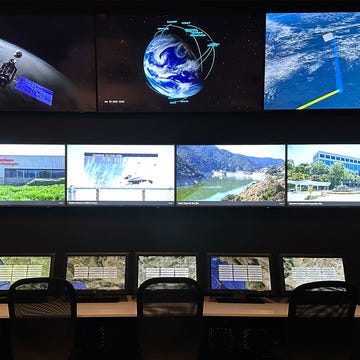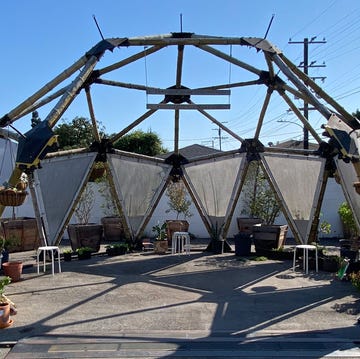Getty’s PST Art: Art & Science Collide festival is the largest art event in the United States. Every Friday, Alta Sketchbook will offer the most intriguing takeaways from the 800-plus artists exploring the collision of art and science through exhibitions across Southern California.
Sign up for our weekly email to have our reviews and recommendations delivered straight to your inbox. And to read our previous coverage, visit Alta Sketchbook: PST Art.
Climb the steps to the second floor of the Hammer Museum and you’ll be greeted by a rambunctious arrangement of planters stuffed with palms, olive trees, philodendrons, and a robust jade plant. It’s no ordinary decorative garden. Tucked among the foliage are a stained glass image of Black Panther Huey Newton and a faux real estate sign for Redline Realty that acerbically advertises the company as “#1 in Gentrifiers!” Grounded, as the installation is titled, was created by Ron Finley, perhaps better known as the Gangsta Gardener of South Los Angeles, who, for more than a decade, has been transforming his Exposition Boulevard property—and the parkway strips around it—into a teeming garden, much of it edible. His work addresses South L.A.’s history of redlining, sprawling food deserts, and inequitable access to green space. In Grounded, he brings literal oxygen to the museum.
Finley is one of more than two dozen artists featured in Breath(e): Toward Climate and Social Justice, the Hammer Museum’s contribution to Getty’s PST Art: Art & Science Collide festival. Organized by artist Glenn Kaino and guest curator Mika Yoshitake, the show was conceived in 2020, when the world was swept by the calamity of the COVID-19 pandemic and the murder of George Floyd. Breath(e) links climate change to social struggles and dethrones humans as the central concern. Take the sculptures by Garnett Puett, whose principal artistic collaborators are bees. Puett, a fourth-generation beekeeper based in Hawaii, creates a frame out of steel—in the shape of a human body or an abstracted geometric structure—then covers it in wax and attracts bees inside. From there, the insects build organic forms. At the Hammer, you’ll find several of Puett’s completed pieces as well as a work in progress that allows viewers to safely watch the bees in action from behind glass.
Breath(e) is an ambitious show, occupying the museum’s lobby and two floors of temporary exhibition spaces. In a series of poignant paintings, Louisiana-based Brandon Ballengée employs crude oil to render aquatic species that have disappeared from the Gulf of Mexico in the wake of the Deepwater Horizon oil spill of 2010. Nearby, Clarissa Tossin presents a silicone cast of a peach tree that died at her Los Angeles home because of excessive heat—its ghostly hull dramatically fills the center of one of the galleries. Other installations engage pollution, ethnobotany, and rising sea levels.
But also included are pieces that are downright puzzling given the stated theme. A number of works, for example, incorporate energy-guzzling tech such as AI and NFTs, begging the question of how such methods fit into a show focused on climate justice. (As I wrote this story, Constellation Energy announced that a nuclear reactor at Three Mile Island in Pennsylvania—site of the worst nuclear accident in U.S. history—would be restored to fulfill Microsoft’s AI energy needs.)
More often, this unwieldy show feels like a loose series of works in search of a guiding principle. A sculpture by Mika Tajima, an artist based in New York, features a laser-etched memory crystal embedded with a year’s worth of data from X accounts in Japan. Mel Chin, a North Carolina artist who has done notable environmentally minded projects in the past, presents a series of 32 small oil paintings, done in the ex-voto style, that chronicle life-changing “phenomenological” experiences in people’s lives. The concept of the work was rooted in the idea of listening without judgment during this present moment of intense social division. “To breathe, we must take in the breath of others,” writes Chin in the show’s catalog. A fine sentiment, but as in my reaction to the crystal, I struggled to understand how it fit within the larger aims of the show.
What’s disappointing is that, in his essay for the catalog, Kaino, who has asthma, cogently articulates why breath is meaningful and how it served as an inspiration for the show. Breath can be science; it can be art; it can be spiritual or political. (Think of the phrase “I can’t breathe,” the last words uttered by Eric Garner, a victim of police violence.) “We can live for days without water and months without food,” writes Kaino, “but suffocate within minutes without drawing a new breath.” Breath(e) would have been far more powerful had it stuck to that potent concept.•
BREATH(E): TOWARD CLIMATE AND SOCIAL JUSTICE
Sept. 14, 2024–Jan. 5, 2025
Hammer Museum
10899 Wilshire Blvd., Los Angeles
Carolina’s Must-Sees
WE LIVE IN PAINTING: THE NATURE OF COLOR IN MESOAMERICAN ART
The history of color in museums is often told through a European lens. This sumptuous exhibition at the Los Angeles County Museum of Art, focused on the material and significance of colors in Indigenous Mesoamerican cultures, helps fill out the story. Through Sept. 1, LACMA
WONDERS OF CREATION: ART, SCIENCE, AND INNOVATION IN THE ISLAMIC WORLD
This beguiling exhibition takes as its starting point an influential encyclopedia of natural phenomena by 13th-century Islamic scholar Zakariyya al-Qazwini. Al-Qazwini approached the world with wonder; after seeing this show, you will too. Through Jan. 5, San Diego Museum of Art
Upcoming Shows
CYBERPUNK: ENVISIONING POSSIBLE FUTURES THROUGH CINEMA
Oct. 6, 2024–Apr. 12, 2026, Academy Museum of Motion Pictures
ANCIENT WISDOM FOR A FUTURE ECOLOGY: TREES, TIME, AND TECHNOLOGY
Oct. 17, 2024–Mar. 2, 2025, Skirball Cultural Center
OPENING DOORS: HUANG YI & KUKA
Oct. 18, 2024, Ramo and Beckman Auditoriums at Caltech
Related Coverage
- “Ron Finley Presents Works in ‘Breath(e): Toward Climate and Social Justice,’” Los Angeles Sentinel
- “Getty’s PST Art Exhibitions Take an Expansive View of Science to Center Indigenous Knowledge,” ArtNews



















